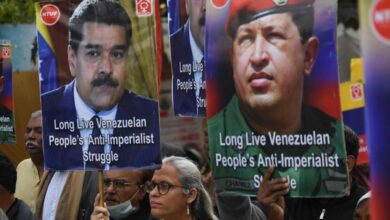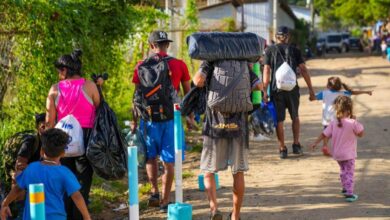Migrant Minors: Discrimination, Illness and Denial of Their Rights
Migrant Minors are Exposed to Many Dangers that Put Their Physical and Emotional Integrity at Risk. The Passage of Boys and Girls Through the Darien Gap has Broken Records. We Tell you About this Situation.

Photo: UNICEF
LatinAmerican Post | María Fernanda Ramírez Ramos
Escucha este artículo
Leer en español: Menores migrantes: discriminación, enfermedad y negación de sus derechos
"The worst nightmare I've ever had" is how Adrianny Ortega, an 8-year-old girl from Venezuela, described her passage through the Darién Gap to journalists from The New York Times. Julie Turkewitz and Federico Ríos followed the footsteps of a group of migrants for 112 kilometers to recount the journey that hundreds of migrants face every day. The report, called " A girl and a dream were lost in the jungle," has gone viral on social media and has taken the story of immigration and the face of 6-year-old Sarah Cuauro to various places.
Thus, Sarah has become the visible face of a humanitarian tragedy in which stories are repeated with one thing in common: the hardships of insecure and forced migration. The number of infants walking through this jungle has reached all-time highs: 32,500 boys and girls have passed through the Darién in the last ten months. Half of them are under the age of 5 and about 900 are not accompanied by their parents. This is an increase of 10% compared to 2021.
This piece of jungle that connects Colombia with Panama is an obligatory passage for those migrants who seek to go from South America to the United States. It is estimated that 211,355 people have crossed the Darien Gap in 2022 (as of October). In their suitcases, they carry dreams of a future with better opportunities. This gives them the courage to embark on a journey that has no guarantee.
During the exhausting days of travel, children and their families are exposed to the dangers of crossing a jungle: insect bites, swollen rivers, dehydration, lack of food, tropical diseases and high levels of physical demand. They are also vulnerable to various forms of violence, "including sexual abuse, trafficking and exploitation," UNICEF said in a press release. In addition, this organization indicates that both in Panama, and in other countries where migratory flows arrive, there is an overflow in the reception of migrant children, which prevents them from receiving basic services that respond to their needs.
In this sense, forced and unsafe migration is one of the biggest challenges in Latin America and the Caribbean, which has a devastating impact on child protection. "Currently, there are two major migration crises: the movement from northern Central America to Mexico and the United States, and the Venezuelan migration crisis. Boys and girls are vulnerable to human trafficking and the smuggling of migrants, especially girls who are more vulnerable to violence, abuse and exploitation," reports Save The Children.
Although the Darien Gap is one of the most neuralgic points on the routes followed by migrants in the Americas region, the hardships and situations of violation of rights for migrants, specifically in childhood, are repeated in various geographical locations. According to data from the UN Refugee Agency (UNHCR), by mid-2022, there were 32.5 million refugees, 53.1 million internal refugees, 4.9 million people seeking asylum and 5, 3 million other people seeking protection. Of the refugees, 76% came from 6 countries: Syria, Venezuela, Ukraine, Afghanistan, South Sudan and Myanmar.
We recommend you read: Infographic: Violence against children in Latin America is up to 4 times higher than the average
Dangers beyond the journey
In addition to the physical and emotional harm that children are exposed to on unsafe migratory paths, they also suffer violations of their rights at their destinations. This is stated in a recent UNICEF report entitled "Denial of rights The effects of discrimination on children." Migrants are especially susceptible to suffering from discourses of exclusion and discrimination, especially those who arrive in unfavorable economic conditions. "Governments must protect children against all forms of discrimination or punishment based on their family's status, nationality, ethnicity, language and religion, among other factors," said Catherine Russell, UNICEF Executive Director. , as an introduction to the aforementioned report.
However, it is a reality that today this protection is not being effective for all children. According to UNHCR information, the best-aged refugees are 5 times less likely to be in school than others. The physical and emotional consequences of difficult journeys, as well as learning a new language and adapting to a new context, are additional obstacles that can limit the development of their potential.
So migration problems are not limited to difficult journeys. The families that manage to reach their desired destinations, for example the United States or some European countries, face situations of discrimination, institutional racism, and difficulties in accessing guarantees that allow them to exercise their rights. "In the United States, race is the single best predictor of access to water and sanitation services. African-American and Latino families are almost twice as likely to lack full plumbing than white families, while indigenous families are 19 times more likely," says the UNICEF report.
Every boy and girl in the world should have guaranteed protection, care, and services for their well-being, regardless of their origin and the reasons for which they migrated. For this, more efforts from the international community and civil society are required, since it is a situation that has enormous dimensions. The truth is also that assistance that is limited to meeting basic needs is not enough; non-racist, non-discriminatory and intercultural assistance is just as important.
Additionally, there is no doubt that more and more will be displaced by natural phenomena and climate migrants, and violent phenomena will continue to occur. For these reasons, it is necessary that the strategies, norms, and policies of care for migrants are increasingly inclusive and effective. Lastly, it is also essential not to allow hate speech and anti-migrant speech, promoted by the extreme right and other radicalized sectors, to end up spreading and being accepted. It is necessary that as citizens we promote against narratives that put human dignity at the center.




